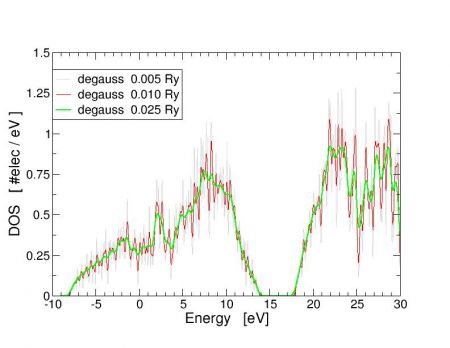Solution LAB1 bands DOS diamond
Revision as of 11:48, 16 December 2020 by Andrea Ferretti (talk | contribs) (→Band structure and DOS of Diamond)
- Back to the previous page: Structural and electronic properties of semiconductors and metals #Convergences
Band structure and DOS of Diamond
Given the calculations run previously to determine the converged set of k-points, ecutwfc, and lattice parameter, here we set the following:
nk = 8 ecutwfc = 60.0 # could be lowered further alat = 6.6694212
As a preliminary step:
- make a new directory, e.g. called Diamond_BANDS
- In a situation like this it is always a good idea to start over from scratch with a fresh scf calculation.
- prepare an input file for a single scf run according to the parameters above.
&CONTROL
calculation="scf"
[...]
/
&SYSTEM
alat=...
ecutwfc=...
/
[...]
K_POINTS {automatic}
8 8 8 0 0 0
- run the calculation as:
mpirun -np 2 pw.x < scf.in > scf.out
- The use of
mpirun -np 2in the example above makes the calculation running on two MPI processes.
We start by addressing the calculation of the DOS.
We need now to write the input file for a non-self consistent calculation using a regular k-point grid. The input file looks like:
>$ cat nscf_dos.in
&CONTROL
calculation="nscf"
verbosity="high" # not strictly needed but useful sometimes
[...]
/
&SYSTEM
alat=...
ecutwfc=...
nbnd=20 # let's include some empty states
/
[...]
K_POINTS {automatic}
20 20 20 0 0 0 # here we use a much denser kpt grid
Then we run it
mpirun -np 2 pw.x < nscf_dos.in > nscf_dos.out
Given the number of k-points requested, the calculation may take some time.
At this point we can prepare an input file for the dos.x program,
$> cat dos.in
&DOS
prefix = 'diamond'
outdir = './SCRATCH/'
degauss=0.025 ! [Ry] broadening parameter
fildos = 'dos_diamond_0.025Ry.dat'
/
The variable degauss controls the gaussian broadening used to approximate
Dirac delta's in the calculation.
Try to change this value to get a feeling of the effect is has on the computed DOS.
An example is show in the figure below.
